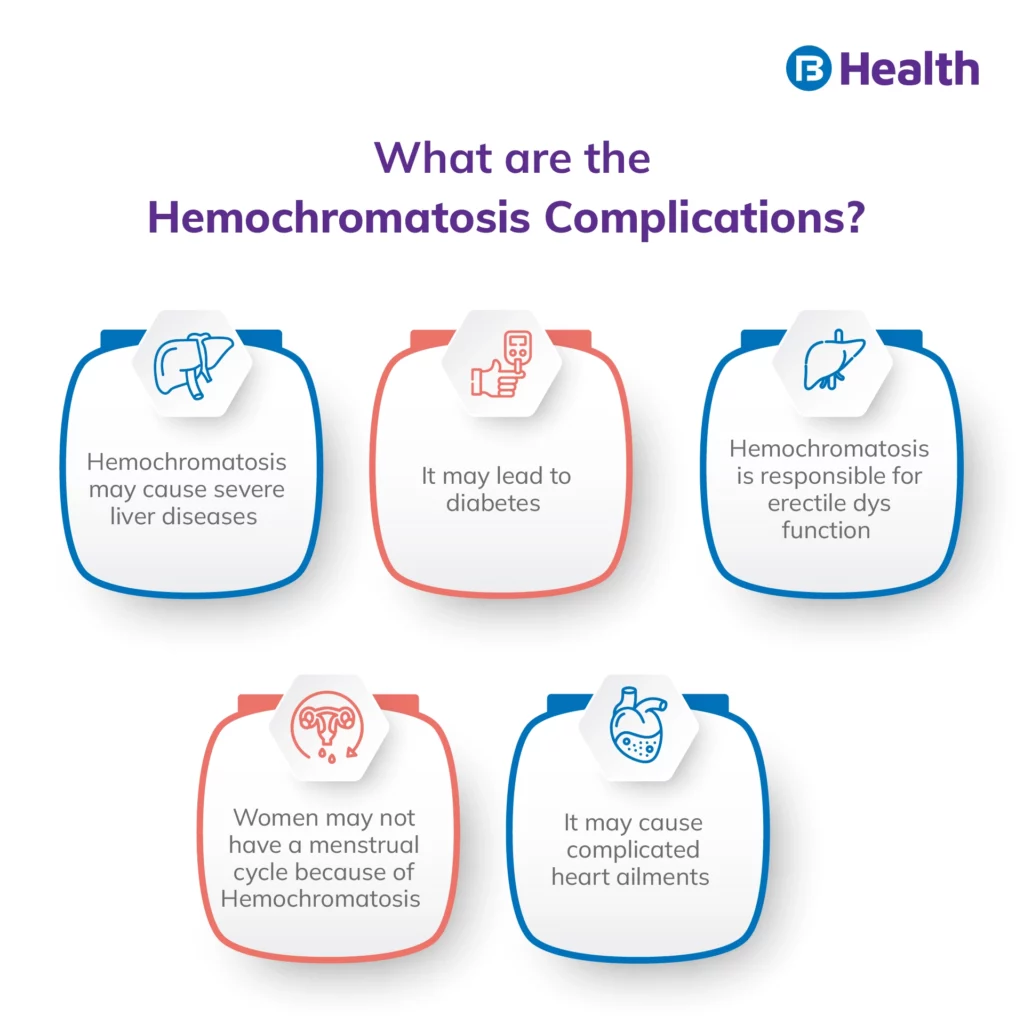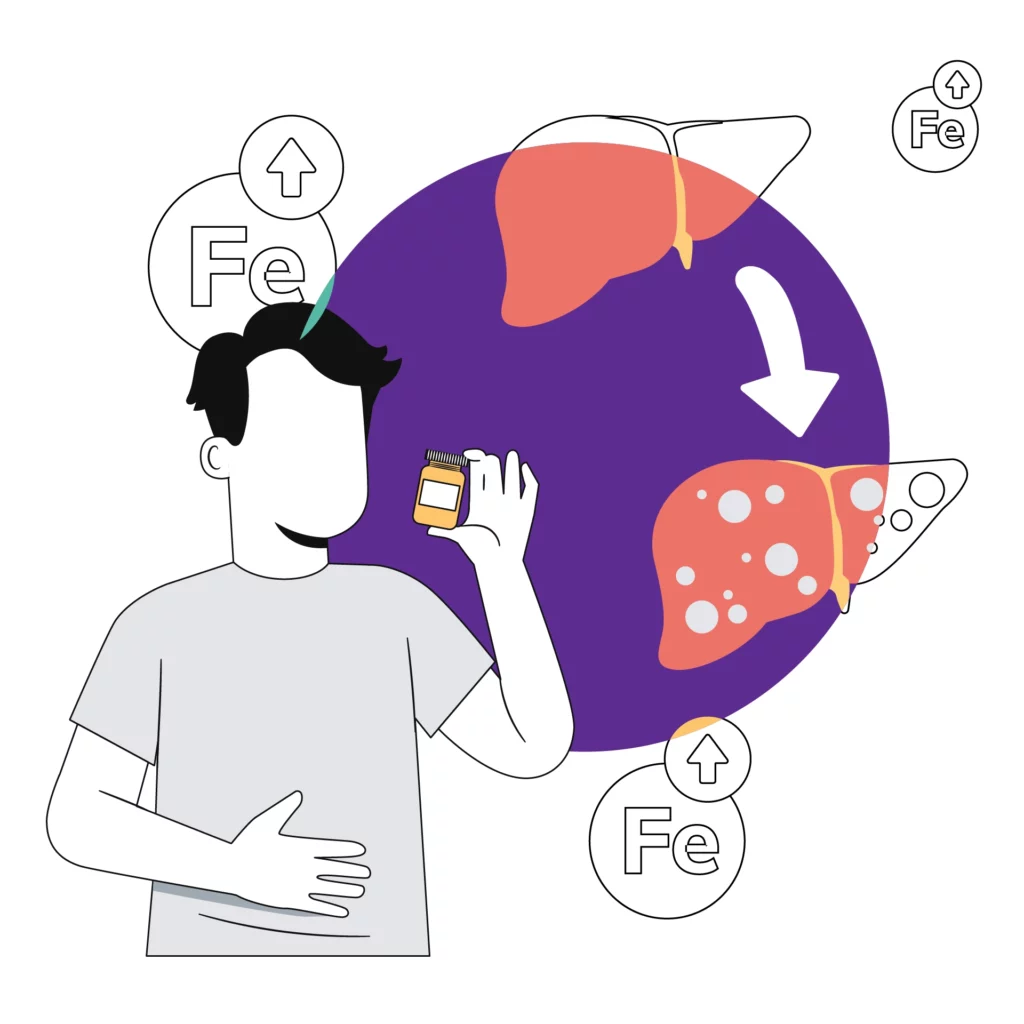General Health | 7 min read
Hemochromatosis (Iron Overload): Symptoms, Diagnosis, Complications
Medically reviewed by
Table of Content
Synopsis
Hemochromatosis can be hereditary and because of other factors as well. It can damage the heart, liver, and joints and can be fatal if not treated correctly at the right time. Read on to learn all about this condition.
Key Takeaways
- The most common type of hemochromatosis is the one passed on through families
- Pain in the knuckles, tiredness, stomach pain, unexplained weight loss, etc., can be just some of the symptoms
- The symptoms might appear only after forty in males and after menopause in females
When you have hemochromatosis, your body absorbs an excessive amount of iron from the foods you consume. Your organs, particularly your liver, heart, and pancreas, hold extra iron. Life-threatening illnesses like liver disease, heart problems, and diabetes can be brought on by an excess of iron.
The most prevalent among hemochromatosis causes a gene alteration that is passed down through generations. Symptoms usually start to show in midlife.
What is Hemochromatosis
Hemochromatosis means a condition in which your body accumulates too much iron. It is sometimes referred to as "iron overload." The proper quantity of iron is usually absorbed by your intestines from the foods you consume.
In hemochromatosis, the body absorbs much more iron than needed and has no way of getting rid of it. Because of this, your body stores extra iron in your joints as well as in your heart, liver, and pancreas and harms them. It might cause your organs to stop functioning if it is not treated.
Additional Read: Serum Iron Test
Causes
Hemochromatosisis caused by a variation in the gene that regulates your body's iron content. Hereditary hemochromatosis is typically passed on from parents to children and can be inherited in the following ways:
- When two abnormal genes are inherited: A hemochromatosis gene can be passed down from parent to child. However, not all children who inherit two abnormal genes develop iron overload.
- When one abnormal gene is transferred from a parent: This is very common and occurs when only one abnormal gene is passed on from a parent.
- Juvenile hemochromatosis: This mutation results from a gene known as the hepcidin gene.
- Neonatal hemochromatosis: It is an autoimmune disorder in which the body attacks itself.
- Secondary Hemochromatosis: This form of hemochromatosis is brought on by an excess of iron and is not inherited. People with anemia and severe liver disease may require blood transfusions, which can lead to iron buildup.
Early Signs of Hemochromatosis
Hemochromatosis, which is present from birth, is the most common type. But for the majority of people, symptoms don't appear until much later in life – typically after age 40 for males and after age 60 for women. Women are more prone to experience symptoms after menopause since they no longer lose iron through menstruation and pregnancy. If you encounter any symptoms, consult a doctor right away. Ask your clinician about genetic testing if someone in your immediate family has hemochromatosis. Genetic testing can determine whether you carry the gene that raises your risk of hemochromatosis.
Additional Read: Iron-Rich FoodSymptoms of Iron Overload
Hemochromatosis symptoms and signs include:
- Joint pain, especially in the knuckles
- Being tired
- Unexplained weight loss
- Bronze or grey-coloured skin
- Abdominal pain
- Loss of sexual drive
- Body hair loss
- Heart flutter
- Foggy memory
Hemochromatosis can sometimes go undetected until other problems start to show up. These may consist of the following:
- Liver disease, like cirrhosis (liver scarring)
- Diabetes
- Abnormal heartbeat
- Erectile dysfunction (trouble having an erection)
- Arthritis
Treatment
Treatment for excessive iron levels is available.
Phlebotomy
Phlebotomy is the main medical hemochromatosis treatment. This entails removing iron and blood from the body. Similar to blood donation, a healthcare expert inserts a needle into a vein, causing blood to flow into a bag.
Initially, about 1 pint of blood will be drawn once or twice a week. You could require treatment every two to four months once your iron levels are back to normal.
Chelation
Chelation is another option. Although it is costly and not a first-line treatment, this emerging medicine can help regulate iron levels. A physician might inject the medication or give you pills. Chelation aids in the body's removal of extra iron through urine and faeces. [1] There could be negative effects, though, including flu-like symptoms and pain in the injected area. People with heart issues or other phlebotomy-related contraindications may benefit from chelation.
Additional Read: Best Food For Brain
How is Hemochromatosis Diagnosed?
Because other disorders share many of the same symptoms as hemochromatosis, it might be challenging for your doctor to make the diagnosis. You might be asked to undergo testing if:
- You're experiencing symptoms
- The disorder is present in a family member
Your doctor can also determine if you have it by using the following methods:
- Checking your history: They'll inquire about your family and whether anyone in your family has hemochromatosis or its symptoms. They may also inquire about liver disease and arthritis, which could indicate that you or a family member has hemochromatosis but is unaware of it.
- Physical exam: Your body will be examined by your doctor. This involves listening to internal processes with a stethoscope. They may also tap on various parts of the body.
- Blood test: Your doctor can learn more about hemochromatosis from the two following tests.
- Transferrin saturation: This demonstrates the quantity of iron that is bound to the protein transferrin, which carries iron in the blood.
If one of these tests shows that you have too much iron, your doctor may request a third test to discover if you have the gene that leads to hemochromatosis.
- Liver biopsy: Your doctor will draw out a small portion of your liver. Then, it will be examined under a microscope to check for liver damage.
- MRI: MRI scan creates an image of your internal organs using radio waves and magnets.
- Genetic testing: A DNA test can reveal whether a person has gene mutations that could cause hemochromatosis. [2] DNA testing might be helpful for those who want to start a family if they have a family history of hemochromatosis.
A medical professional may take a sample of your blood or employ a swab to obtain cells from your mouth for the test.
Complications
Hemochromatosis, if left untreated, can result in several consequences. These issues primarily affect your joints and organs that accumulate excess iron, such as your liver, pancreas, and heart. Possible complications include:
- Liver problems: One of the potential issues is cirrhosis, which causes the liver to scar permanently. Your likelihood of developing liver cancer and other serious problems rises if you have cirrhosis
- Diabetes: Diabetes may develop as a result of pancreatic damage
- Heart issues: The ability of the heart to circulate sufficient blood for the body's requirements is impacted by excess iron in the heart. This is known as congestive heart failure. Hemochromatosis can also cause irregular heart rhythms, known as arrhythmias
- Reproductive issues: Excess iron in men can cause erectile dysfunction and a loss of sexual drive. It could prevent women from having their menstrual cycle.
- Skin colour changes: Iron deposits in skin cells can cause hemochromatosis skin.It makes your skin grey or bronze in colour
Other secondary hemochromatosis risk factors include:
- Dependence on alcohol
- A history of diabetes, heart or liver disease in the family
- Consuming Vitamin C or Iron supplements that can increase the body's absorption of iron
- Frequent blood transfusions
Types
- Juvenile hemochromatosis: This type of hemochromatosis affects young adults in the same way that hereditary hemochromatosis affects adults. Iron accumulation starts earlier, and symptoms typically appear between the ages of 15 and 30.
- Neonatal hemochromatosis: It is a deadly condition in which the fetus's liver begins to quickly accumulate iron.
- Secondary hemochromatosis: When an accumulation of iron results from another medical illness, it is known as secondary hemochromatosis. Red blood cells discharge an excessive amount of iron into the body.
If you notice any of the above symptoms, consult a doctor right away. It is very crucial to receive proper treatment before any organ damage. A normal lifespan is very likely with early treatment. By making an online appointment for a General physician consultation at Bajaj Finserv Health, you can get to know more about hemochromatosis, do tests, and get efficient treatment if you are diagnosed.
References
- https://www.ncbi.nlm.nih.gov/books/NBK269373/
- https://www.ncbi.nlm.nih.gov/pmc/articles/PMC4334066/
Disclaimer
Please note that this article is solely meant for informational purposes and Bajaj Finserv Health Limited (“BFHL”) does not shoulder any responsibility of the views/advice/information expressed/given by the writer/reviewer/originator. This article should not be considered as a substitute for any medical advice, diagnosis or treatment. Always consult with your trusted physician/qualified healthcare professional to evaluate your medical condition. The above article has been reviewed by a qualified doctor and BFHL is not responsible for any damages for any information or services provided by any third party.





